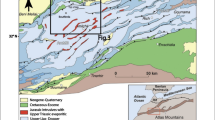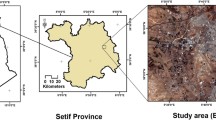Abstract
Supervised classification and Crosta technique is widely used for lithological and alteration zone mapping respectively. Landsat ETM+ digital imagery has been used to generate Crosta and Supervised classification image using digital image processing (DIP) technique. In the study, The Crosta technique has been used for the first time in lithological mapping. These techniques were applied to distinguish the litho-contacts between Alwar and Ajabgarh quartzite in the south-western part of North Delhi Fold Belt (NDFB) on the basis of argillaceous and arenaceous nature of the rocks. Litho contacts between Alwar and Ajabgarh groups are varying from quartzite to biotite schist in the Khetri basin whereas in the study area the litho-contacts are Alwar quartzite to Ajabgarh quartzite which are very difficult to classify on naked eye. Therefore, this area has been selected for this study. Several authors have studied the geological setting of Khetri sub basin and classified on the basis of argillaceous, arenaceous nature and primary sedimentary structural features like ripple marks and cross bedding. This is the first attempt in the Khetri sub basin for lithological classification based on remote sensing and digital image processing technique. This study revealed that Crosta image has significant spatial correlation with the lithology discriminated using Supervised classification technique. Lithological variations were clearly demarcated using these technique around Rahunathgarh and Golyana areas. The litho units between these areas were marked under the Group of Ajabgarh quartzite by the GSI people during 1994. However, the present study classified those area under the Group of Alwar quartzite. Similar type of studies can also be carried out where these type of lithological problems arises.








Similar content being viewed by others
References
Abarca-Hernández, F. & Chlca-Olmo, M. (1999). Evaluation of geostatistical measures of radiometric spatial variability for lithologic discrimination in landsat TM images http://asprs.org/a/publications/pers/99journal/june/1999_jun_705-711.pdf.
Crosta, A P., & McM. Moore, J. (1989). Enhancement of Landsat thematic mapper imagery for residual soil mapping in SW Minas Gerais State, Brazil: A prospective case history in greenstone belt terrane. Proceedings of the 7th Thematic Conference: Remote Sensing for Exploration Geology, Calgary, Alberta, Canada, Oct. 2-6, pp. 1173–1187.
Das Gupta, S. P. (1968). The structural history of the Khetri Copper Belt. Jhunjhunu and Sikar districts, Rajasthan. Memories of the Geological Survey of India, 98, 1–150.
Gad, S., & Kusky, T. (2006). Lithological mapping in the eastern desert of Egypt, the Barramiya area, using landsat thematic mapper. Journal of African Earth Sciences, 44, 196–202.
Heron, A.M (1917), Geology of Northeastern Rajputna and adjacent districts. Memoirs - Geological Survey of India, v. 45, p. 1–389
Hubbard, B. E., & Crowley, J. K. (2005). Mineral mapping on the Chilean–Bolivian Altiplano using co-orbital ALI, ASTER and Hyperion imagery: Data dimensionality issues and solutions. Remote Sensing of Environment, 99,(1–2), 173–186.
Liu, L., Zhuang, D. -F., Zhou, J., & Qiu, D. -S. (2011). Alteration mineral mapping using masking and Crosta technique for mineral exploration in mid-vegetated areas: a case study in Areletuobie, Xinjiang (China). International Journal of Remote Sensing, 32,(7), 1931–1944
Levergton, D. W. (2010). Discrimination of sedimentary lithologies using hyperigon and Landsat Thematic data: a case study at Melville Island, Canadian High Arctic. International Journal of Remote Sensing, 31(1), 233–260 Online publication dated 13 January 2010.
Mars, J. C., ∓ Rowan, L. C. (2011) ASTER spectral analysis and lithologic mapping of the Khanneshin carbonate volcano, Afghanistan. Geosphere. 7, 276–289.
Ranjbar, H. (2002). Application of Crosta technique for porphyry Copper alteration mapping, using ETM+ data: a case study of Meiduk and SAR Cheshmeh areas, Kerman. Journal of Exploration and Mining Geology. v. 11; no. 1–4; p. 43–48.
Roy, A. B. (1988). Stratigraphic and tectonic framework of the Aravalli mountain range. Memoirs of the Geological Society of India, 7, 3–31.a.
Author information
Authors and Affiliations
Corresponding author
About this article
Cite this article
Muthamilselvan, A. Application of Supervised Classification and CrostaTechnique for Lithological Discrimination in Parts of South Khetri Belt, Sikar District, Rajasthan. J Indian Soc Remote Sens 45, 377–383 (2017). https://doi.org/10.1007/s12524-016-0589-y
Received:
Accepted:
Published:
Issue Date:
DOI: https://doi.org/10.1007/s12524-016-0589-y




